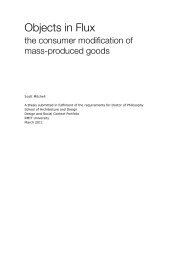Making Memory Space: Recollection and Reconciliation in Post ...
Making Memory Space: Recollection and Reconciliation in Post ...
Making Memory Space: Recollection and Reconciliation in Post ...
Create successful ePaper yourself
Turn your PDF publications into a flip-book with our unique Google optimized e-Paper software.
performative aspects of the memorial have imbued the site <strong>and</strong> memory space with a degree of<br />
significance usually attributed to sites that have witnessed events of the past. Instead, this site has<br />
garnered mean<strong>in</strong>g entirely through the fabricated production of events, <strong>in</strong>tentionally conceived to<br />
reiterate the mean<strong>in</strong>g attributed to the memorial. S<strong>in</strong>ce the symbolism <strong>in</strong>herent <strong>in</strong> the structure so<br />
clear, is it possible to re-evaluate the context <strong>in</strong> which the memorial is understood?<br />
Contested mean<strong>in</strong>gs<br />
Robert Musil’s famous claim of 1927 that ‘there is noth<strong>in</strong>g so <strong>in</strong>visible <strong>in</strong> the world as a monument’ is<br />
readily contested <strong>in</strong> the Voortrekker Monument. 136 Here, rather than becom<strong>in</strong>g mean<strong>in</strong>gless as the<br />
regime that conceived of the monument crumbles, the retention of the memorial <strong>and</strong> the constant<br />
dialogue over its mean<strong>in</strong>g ensure that it rema<strong>in</strong>s significant with<strong>in</strong> the national psyche. Nevertheless, it<br />
is worth exam<strong>in</strong><strong>in</strong>g Musil’s argument to ascerta<strong>in</strong> whether ultimately the memorial may lose its potency<br />
over time. Musil’s position is based on three primary po<strong>in</strong>ts: one, that familiarity breeds banality; two,<br />
that competition with media advertis<strong>in</strong>g underm<strong>in</strong>es potency of monuments; <strong>and</strong> three, that the<br />
disjunction between everyday sett<strong>in</strong>gs <strong>and</strong> heroic narratives renders the monuments ridiculous. He<br />
argues that the function of monuments, to facilitate the cohesion of social groups through the<br />
construction of collective memory, has rema<strong>in</strong>ed relatively unchanged over time even through the<br />
messages have differed immensely. Musil firmly situates the monumental impulse of architecture<br />
with<strong>in</strong> a European tradition. He aligns the mythic <strong>and</strong> human icons of sepulchre art from the Middle<br />
Ages, with decorative sculpture of the Renaissance <strong>and</strong> the Baroque, <strong>and</strong> <strong>in</strong> turn with n<strong>in</strong>eteenth-<br />
century national memorials <strong>and</strong> war memorials of the twentieth century. 137 In a South African context<br />
his argument is underm<strong>in</strong>ed for, arguably, the assertion of the European tradition presents a<br />
cont<strong>in</strong>uance of colonialist notions of what constitutes memorial. Perhaps one of the most problematic<br />
aspects of the attempts to use the Voortrekker Memorial as an emblem of a common history stems<br />
from the fact that the memorial is grounded <strong>in</strong> a very specific European tradition, one which by its very<br />
nature denies commonality. David Bunn suggests that the naturalis<strong>in</strong>g of monuments amidst the<br />
l<strong>and</strong>scape is made difficult <strong>in</strong> South Africa, because of their <strong>in</strong>ability to convey collective mean<strong>in</strong>g. This<br />
is due to their ‘reluctance to imag<strong>in</strong>e the idea of citizenship outside the boundaries of race.’ 138 His<br />
position, that monuments struggle to be seen when they rely on the memorial practices of a m<strong>in</strong>ority<br />
group, adds weight to the argument that it is only through the re-characterision of the memorial -<br />
attempt<strong>in</strong>g to situate it <strong>in</strong> a more common place - that the cont<strong>in</strong>ued significance of the memorial is<br />
ensured.<br />
Return<strong>in</strong>g to the broader questions of the <strong>in</strong>visibility of monuments, Andreas Huyssen proffers a<br />
fasc<strong>in</strong>at<strong>in</strong>g evaluation of Christo’s ‘Wrapped Reichstag’ as a means of exam<strong>in</strong><strong>in</strong>g how monuments<br />
136<br />
Robert Musil as quoted <strong>in</strong> Peter Carrier, Op cit, p.15.<br />
137<br />
Ibid, p.17.<br />
138<br />
David Bunn, Op cit, p.93.<br />
46
















